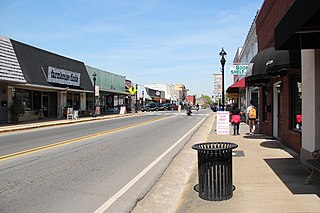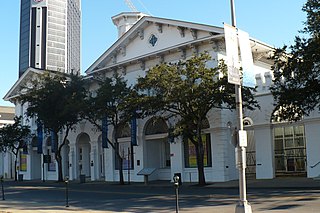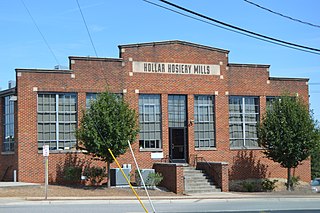
Fort Payne is a city in and county seat of DeKalb County, in northeastern Alabama, United States. At the 2020 census, the population was 14,877.

The Highland Park Ford Plant is a former Ford Motor Company factory located at 91 Manchester Avenue in Highland Park, Michigan. It was the second American production facility for the Model T automobile and the first factory in history to assemble cars on a moving assembly line. It became a National Historic Landmark in 1978.

Hanes and Hanes Her Way is a brand of clothing.

The Colt Armory is a historic factory complex for the manufacture of firearms, created by Samuel Colt. It is located in Hartford, Connecticut along the Connecticut River, and as of 2008 is part of the Coltsville Historic District, named a National Historic Landmark District. It is slated to become part of Coltsville National Historical Park, now undergoing planning by the National Park Service.

Pullman National Historical Park is a historic district located in Chicago and was the first model, planned industrial community in the United States. The district had its origins in the manufacturing plans and organization of the Pullman Company and became one of the most well-known company towns in the United States, as well as the scene of the violent 1894 Pullman strike. It was built for George Pullman as a place to produce the famous Pullman sleeping cars.

Old City Hall, also known as the Southern Market, is a historic complex of adjoining buildings in Mobile, Alabama, that currently houses the History Museum of Mobile. The complex was built from 1855 to 1857 to serve as a city hall and as a marketplace. It was declared a National Historic Landmark in 1973, as a rare well-preserved example of a 19th-century multifunction civic and commercial building.

The Ipswich Mills Historic District encompasses a major textile mill complex and associated worker housing along the Ipswich River near the center of Ipswich, Massachusetts. The district includes the factories of the Ipswich Mill Company, and several blocks of modest worker cottages mostly on side streets off Estes and Kimball Streets. The site had been used as for mills since the 17th century, and was purchased by the Ipswich Mill Company in 1868. Mill worker housing was built surrounding the complex through the early 20th century, when River Court, Peatfield Street, and 1st through 6th Streets were laid out. The district was listed on the National Register of Historic Places in 1996.

The American Bank Note Company Building is a five-story building at 70 Broad Street in the Financial District of Manhattan in New York City. The building was designed by architects Kirby, Petit & Green in the neo-classical style, and contains almost 20,000 square feet (1,900 m2) of space, with offices and residences on the upper floors. The exterior consists of a main facade on Broad Street with two columns, as well as side facades with pilasters on Beaver and Marketfield Streets.

The H. J. Heinz Company complex, part of which is currently known as Heinz Lofts, is a historic industrial complex in the Troy Hill neighborhood of Pittsburgh, Pennsylvania. The buildings were built by the H. J. Heinz Company from 1907 through 1958. The complex is listed on the National Register of Historic Places (NRHP) and five of the buildings are listed as a Pittsburgh History and Landmarks Foundation Historic Landmark.

Reading Knitting Mills is a historic factory building located in Reading, Berks County, Pennsylvania. It was built in 1891, and expanded in 1898, and about 1920. It is a four-story, 15 bay by 4 bay, brick building with Italianate style influences. It has a corbelled brick cornice and slate covered gable roof. It has a brick boiler house annex and one-story addition built in 1898. The fourth floor was added to the original three-story building about 1920.

The Ziock Building is a historic skyscraper in Rockford, Illinois. Throughout its history, it has also been known as the Amerock Building and the Tower Building. Originally the home to several manufacturing enterprises owned by William H. Ziock, Jr., the tower became the headquarters of Amerock in the 1940s.

Cherokee Plantation is a historic house in Fort Payne, Alabama. The house was built in 1790 as a two-story log cabin by Andrew Ross, a judge on the Cherokee Supreme Court and brother of Principal Chief John Ross. In 1834 a second log cabin was built connected to the rear of the original cabin, and a third was built to the northeast, separated by a breezeway. Ross, being one-eighth Cherokee, was forced to leave his home in 1838 under the provisions of the Treaty of New Echota, of which Ross was a signatory; a portion of the Cherokee Trail of Tears passes in front of the house.

The Busiel-Seeburg Mill is a historic mill building in Laconia, New Hampshire, since converted into an office building known as 1 Mill Plaza. This 3-1/2 story brick structure achieved its present configuration in stages, beginning in 1853, and successively altered and expanded through the rest of the 19th century. The business, established by John W. Busiel in 1846, manufactured knitted hosiery, and was one of the first producers of knitwear to use circular knitting machines invented by Aiken and Peppers. The building was listed on the National Register of Historic Places in 1971.

The Fort Payne Boom Town Historic District is a historic district in Fort Payne, Alabama. The district encompasses five properties built around 1889, when Fort Payne was undergoing huge growth owing to the area's mineral deposits. Included are the Alabama Great Southern Depot; the Fort Payne Opera House; the Sawyer Building, a two-story Victorian commercial building; City Park, which sat across from the (now-demolished) county courthouse; and Purdy Furniture, which built as the headquarters of the Fort Payne Coal and Iron Company. Another Victorian commercial building has since been demolished. The district was listed on the National Register of Historic Places in 1989.

The Fort Payne Residential Historic District is a historic district in Fort Payne, Alabama. The district represents both of Fort Payne's major periods of growth: the 1880s and 1890s, fueled by the area's mineral deposits; and the 1910s through the 1930s, bolstered by the development of the hosiery industry. The area was predominantly middle class, meaning only a few Queen Anne homes were built; most houses from the early period were built in more restrained Vernacular Victorian styles. Later construction is dominated by American Foursquares and Craftsman Bungalows. The district was listed on the National Register of Historic Places in 1988.

Hollar Hosiery Mills-Knit Sox Knitting Mills is a historic knitting mill located at Hickory, Catawba County, North Carolina. It consists of two mill brick manufacturing buildings and a boiler house that were connected by a hyphen in the mid-1960s. The first mill building was built about 1930, and is a one- to two-story, 16 bay, brick veneer structure. The boiler house was also built about 1930, and is a small, brick building, with its flat roof and terra cotta coping. The hosiery yarn mill was built about 1940, and is two-story, six bay by 10 bay, brick-veneered building. Both mill buildings feature banks of steel-sash factory windows. The knitting mill operated until 1968.

Whisnant Hosiery Mills, also known as Moretz Mills, is a historic knitting mill located at Hickory, Catawba County, North Carolina. It is a one- to two-story, trapezoidal shaped brick building consisting of contiguous sections built in 1929, 1937, the 1940s, the 1950s, and 1966. The mill closed in 2011. It was listed on the National Register of Historic Places in 2013. The property underwent a significant rehabilitation using historic tax credits and re-opened as a mixed use space in April 2015. The property was designated a local historic landmark by the City of Hickory in August 2015.

Durham Hosiery Mill is a historic textile mill complex located at Durham, Durham County, North Carolina. It includes seven contributing brick buildings in the complex. The original Durham Hosiery Mill was built in 1902, and consists of a four-story main building with a six-story Romanesque Revival style tower in front; engine, boiler, and heater houses attached at the rear, and a one-story dye house. The main building was expanded with a two-story annex in 1904, and a three-story annex in 1906. Other buildings include the triangular Annex No. 1 (1912) and a three-story brick finishing building. By 1910, the Durham Hosiery Mills Corporation was the largest manufacturer of cotton hosiery in the world. The mill was abandoned in 1922.

P.H. Hanes Knitting Company is a historic textile mill complex located at Winston-Salem, Forsyth County, North Carolina. The complex includes three buildings. The Knitting Building or North Building was built in 1920–1921, and is a six-story, Beaux-Arts style concrete and steel building sheathed in brick. The Mill Building or East Building was built in 1928, and is a five-story-plus-basement building of concrete, brick, and steel construction. The Warehouse and Shipping Building was built in 1940, and is a six-story steel frame building sheathed in brick. The P.H. Hanes Knitting Company was founded in 1901 by Pleasant H. Hanes, brother of John W. Hanes who founded Shamrock Mills, later Hanes Hosiery. In February 1965, P. H. Hanes Knitting Company merged with Hanes Hosiery. The downtown mill complex closed in 1965. The complex has been converted to loft apartments.

The Amazon Hosiery Mill, also known as the Amazon Knitting Mill, is a former industrial building located at 530-550 West Western Avenue in Muskegon, Michigan. It now houses the Amazon Apartments. The building was listed on the National Register of Historic Places in 1982.
























